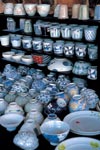|
|
 |
(1) |
Imari at dawn. Photo taken from Take no Koba Park,
which is situated on the Kunimi Range in the western part of the city. |
|
|
|
 |
(2) |
Porcelain and pottery
stores line both sides of Arita's main street. |
|
|
|
 |
(3) |
At the Museum of Kyushu Ceramic Arts you can admire porcelain and pottery and learn about their history. Exhibition of works from Arita and other production centers in Kyushu. Japanese-language website:
http://www.pref.saga.lg.jp/at-ontents/ kanko_bunka/k_shisetsu/kyuto/ |
|
|
|
 |
(4) |
Sakaida Kakiemon Kiln. Arita ceramics have three distinctive styles: Kakiemon, Ko-Imari and Nabeshima wares. The current Kakiemon, the 14th in a line of illustrious craftsmen, carries on the old traditions. |
|
|
|
 |
(5) |
Mugs without handles, rice bowls and many other pieces show off their different colors and patterns at a store in Arita. |
|
|
|
 |
(6)
|
Photos of the climbing kiln operated by Fukagawa Seiji Company. This type of kiln takes advantage of a natural incline. In the old days all kilns in Arita were this type. |
|
|
|
 |
(7) |
Red, yellow and green—typical colors for waenogu picture ware dyes. A store called Tsujienogu in Akae-machi still makes this type of dye. |
|
|
|
 |
(8) |
Porcelain clay for Arita ware was mined here at Izumiyama. Ri Sampei, the father of Arita ware, is said to have discovered the clay here. |
|
|
|
 |
(9) |
Red dyes thrown away from the atelier beside the old stone wall ended up coloring the wall. If you stroll along lanes leading away from Arita's main street you will come across memorable scenes typical of an old ceramic production center. |
|








